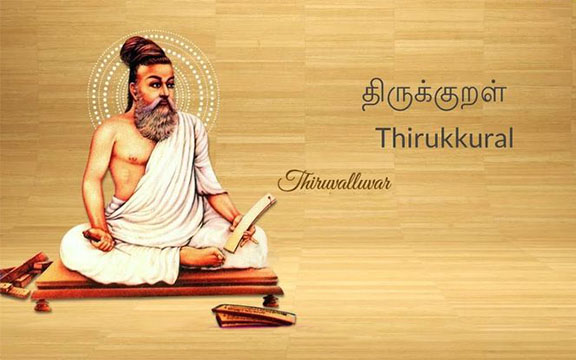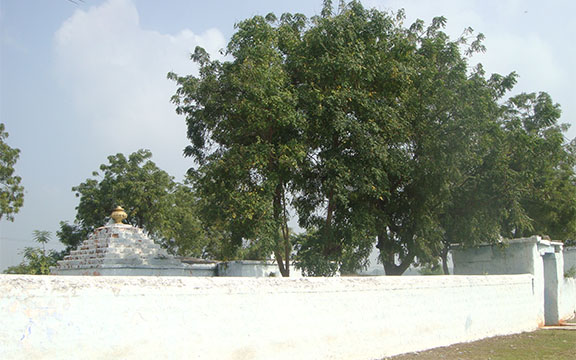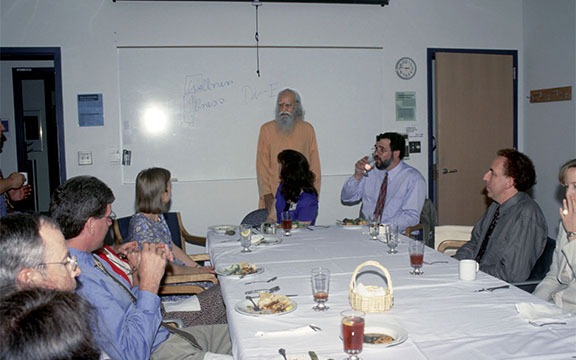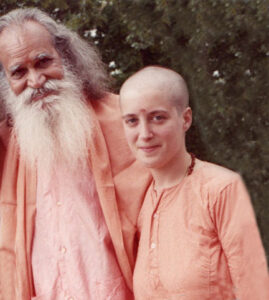
Depiction of Thiruvalluvar holding the palm leaf manuscript and tool he used to write.
As a young boy, Ramu (Swami Satchidananda’s birthname was Ramaswamy, Ramu for short) was deeply immersed in Tamil culture and spirituality. One of the most significant influences in his life was the Thirukkural, a revered Tamil text written by the celebrated poet and philosopher Thiruvalluvar. This text played a central role in Ramu’s family life and education. Though the exact dates of his life are debated,
Thiruvalluvar is traditionally believed to have lived between the 4th century BCE and the 1st century CE. He is often depicted as a humble weaver, a profession symbolizing his deep connection to the common people. His life and teachings have left an indelible mark on Tamil culture, shaping ethical and moral thought for centuries.
Growing up, Ramu was surrounded by the teachings of the Thirukkural—at home and at school—which emphasized virtues such as ahimsa (non-violence), truthfulness, and integrity. These teachings were not just theoretical for Ramu; they were a living, breathing part of his daily existence, shaping his ethical foundation and life.
The Thirukkural, consisting of 1,330 kurals (couplets) divided into three sections—Aram (virtue), Porul (wealth), and Inbam (love)—covers a wide range of topics, including ethics, politics, economics, and love. Thiruvalluvar’s work is renowned for its universal values and practical wisdom, promoting a way of life that transcends religious and cultural boundaries. For Ramu, the Thirukkural was more than just a text; it was a guide to living a righteous and fulfilling life. His father ensured that these teachings were ingrained in him from a young age, reinforcing the importance of non-violence and compassion in every aspect of life.
A Young Orator’s Journey
Ramu’s dedication to the principles of ahimsa was evident from an early age. In 1921, at the tender age of seven, he asked his father if he could accompany him to the annual five-day conference held at the Sad Vidhya Sanmarga Sangam of Sandalinga Swamigal Mutt in Perur. Not only did Ramu want to listen to the well-known lecturers and swamis, but he also wished to give a short talk. His father suggested the topic of ahimsa, an important component of their home life, and helped him prepare. Ramu practiced diligently, ensuring he could pronounce the complex name of the presiding swami, Subbiah Swamigal, correctly.

Photo: The village of Perur, South India.
Ramu was scheduled to speak on a day when Subbiah Swamigal, a particularly well-known swami, would preside as chairman. Actually, the swami’s full name was much longer and quite complicated. Ramu practiced and practiced—not only his talk, but the correct pronunciation of the swami’s name as well. At Perur, the hour arrived and Ramu mounted the platform with a serious expression. Subbiah Swamigal read from the schedule, “Now, Ramaswamy will deliver a lecture on ahimsa.” He smiled at the tiny form of his guest lecturer, who was mounting the platform with such a serious expression. He was the youngest speaker in the history of the conference.
“First of all,” a loud, high voice declared, “let me offer my humble salutations to the chairman of this session, Sennai Sri Jagathgurupidam Nayachandra Vedanta Bhashkara Srimath Mahamandaleshwara Veerasubbiah Jnana Desikendra Swamigal and to you all.” The perfect recitation of this complex name drew a prolonged round of applause. Subbiah Swamigal, impressed by the young boy’s eloquence, lifted him onto his lap and asked him to deliver his talk from that position. Ramu’s talk on ahimsa was well received, and he became the youngest speaker in the history of the conference.
The Thirukkural’s emphasis on ahimsa is profound and is reflected in verses such as:
- Verse 311: “Even if it yields glory and riches galore, refraining from harming others is the principled path of the impeccable.”
- Verse 320: “Harm descends on those who harm others; hence those who wish not to be harmed do no harm.”
- Verse 321: “What is a righteous deed? Not killing. Killing leads to everything evil.”
- Verse 323: “Not killing is the foremost virtue; it is followed by not lying.”
These teachings were not just theoretical for Ramu but were ingrained in his daily life and practices. His father’s choice of topic for his first public talk underscores the importance of these values in their family. This experience marked the beginning of Ramu’s journey as a proponent of non-violence and ethical living, deeply influenced by the teachings of the Thirukkural. As long as Ramu lived in that area, he was a guest speaker at that conference.
A Lifelong Commitment to Vegetarianism and Ahimsa
The Thirukkural also emphasized the importance of a vegetarian diet, which Ramu’s immediate family strictly followed. Verses from the text were of deep import including these:
- Verse 251: “How can someone possess kindness if one eats meat from another body to grow one’s own body?”
- Verse 257: “Meat is the wound of some body; if one gets this realization, stop eating it.”
- Verse 258: “Those who have wisdom free of flaws would not eat a body freed of its life.”
- Verse 259: “To desist from killing a life and eating it is better than doing a thousand rituals offering oblation.”
- Verse 260: “To one who doesn’t kill and refuses meat, all lives will fold their arms and pay obeisance.”

Photo: Ramu (tallest boy pictured) with cousins.
These verses highlight the ethical and spiritual significance of vegetarianism. Despite the strict vegetarianism of his immediate family, some of Ramu’s relatives ate meat, prepared in separate kitchens and served in different dining rooms. During visits to these relatives, Ramu would often join his cousins on hunting trips, though he initially participated reluctantly. One such experience, where he shot a bird and witnessed the anguish of its mate, left a profound impact on him. He vowed never to harm another creature again, a promise he kept by deliberately disrupting future hunting trips with fits of coughing and sneezing to scare away the animals, and living a life of ahimsa.
Ramu’s early experiences with the principles of ahimsa and vegetarianism set the stage for a lifelong commitment to these values. As he grew older, his dedication to non-violence only deepened. He began to understand the broader implications of ahimsa, not just in terms of physical non-violence, but also in thoughts and words. This holistic approach to ahimsa shaped his interactions with others and guided his life.
Contributions to Western Medicine
Ramu’s journey eventually led him to take vows of sannyasa and he became Swami Satchidananda. As Swami Satchidananda, he traveled the globe, spreading the message of ahimsa and the benefits of a vegetarian lifestyle. He emphasized the importance of harmony between mind, body, and spirit, advocating for a holistic approach to health and well-being. His teachings resonated with people from various backgrounds and cultures, as he presented ancient wisdom in a manner that was accessible and relevant to contemporary society.
Sri Swamiji’s holistic health perspective was revolutionary for its time. He was among the early thought leaders to introduce the concept of the mind-body connection to Western audiences, advocating for stress reduction through Yoga practices and philosophy, and living in harmony with nature. He steadfastly promoted a vegetarian diet as a cornerstone of this holistic health approach. His belief was that physical health could not be separated from mental and spiritual health, and that a non-violent lifestyle, including a vegetarian diet, was essential for overall well-being.

Photo: Swami Satchidananda meeting with doctors at Univ. of Virginia Medical Center, 1999.
Swami Satchidananda’s teachings on ahimsa and vegetarianism had a significant impact on Western medicine, especially through some of his students who have become luminaries in the field of complementary medicine and Yoga therapy including Dr. Sandra Amrita McLanahan and Dr. Dean Ornish. Sri Swamiji’s book, The Healthy Vegetarian (later retitled The Yoga Way: Food for Body, Mind, and Spirit), encapsulated his teachings on the subject.
He taught that treating symptoms without addressing the root cause of disease was akin to cutting the wires of a home smoke alarm—an approach that would ultimately fail to prevent further harm. This perspective was prophetic and contributed to the development of what is now known as lifestyle medicine.
Swami Satchidananda’s advocacy for holistic health and lifestyle medicine paved the way for a new understanding of well-being. His teachings on the importance of diet, mental health, and ethical living have left a lasting legacy. He was a pioneer in promoting the idea that disease was essentially a state of “dis-ease” or disturbed ease, often caused by unhealthy habits, wrong thinking, and stress. His work has influenced countless individuals and continues to inspire a more compassionate and ethical approach to health and life.
Sri Swamiji’s journey, deeply rooted in the principles of Tamil culture and the teachings of the Thirukkural, exemplifies the profound impact of traditional wisdom on modern life. His unwavering commitment to ahimsa and ethical living serves as an inspiration to many, demonstrating that ancient teachings can offer valuable guidance in contemporary society. He left a lasting legacy of compassion, non-violence, and holistic health, reminding us of the timeless relevance of the Thirukkural’s wisdom. His service in promoting Yoga, holistic health, and ethical living has had a lasting impact, creating ripples that continue to influence new generations. By following in his footsteps and embracing the principles of ahimsa, we can ensure that his message of compassion and non-violence remains a guiding light for the future.
About the Author:
 Swami Premananda, Ph.D. is a senior disciple of Sri Gurudev Swami Satchidananda and served as his personal and traveling assistant for 24 years. Her interest in the study of the spiritual roots of the Integral Yoga tradition and lineage was inspired over many years of traveling with Sri Gurudev to the various sacred sites throughout India that are a part of this tradition. She also undertook a 2-year immersion into the nondual Saiva Yoga Siddhar tradition that is at the heart of Sri Gurudev’s spiritual roots. She further studied the history, sacred texts, and teachings of Tamil Saivism including the Siddhars, bhakti poet saints, as well as the spiritual luminaries who lived in the 19th – 20th centuries and who inspired Sri Gurudev, such as Sri Ramana Maharshi, Swami Ramdas, and Swami Vivekananda. She serves as editor of Integral Yoga Magazine, Integral Yoga Publications; senior archivist for Integral Yoga Archives; and director of the Office of Sri Gurudev and His Legacy.
Swami Premananda, Ph.D. is a senior disciple of Sri Gurudev Swami Satchidananda and served as his personal and traveling assistant for 24 years. Her interest in the study of the spiritual roots of the Integral Yoga tradition and lineage was inspired over many years of traveling with Sri Gurudev to the various sacred sites throughout India that are a part of this tradition. She also undertook a 2-year immersion into the nondual Saiva Yoga Siddhar tradition that is at the heart of Sri Gurudev’s spiritual roots. She further studied the history, sacred texts, and teachings of Tamil Saivism including the Siddhars, bhakti poet saints, as well as the spiritual luminaries who lived in the 19th – 20th centuries and who inspired Sri Gurudev, such as Sri Ramana Maharshi, Swami Ramdas, and Swami Vivekananda. She serves as editor of Integral Yoga Magazine, Integral Yoga Publications; senior archivist for Integral Yoga Archives; and director of the Office of Sri Gurudev and His Legacy.

